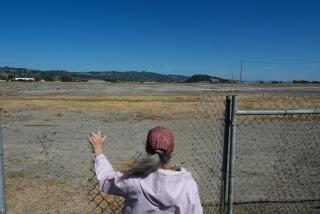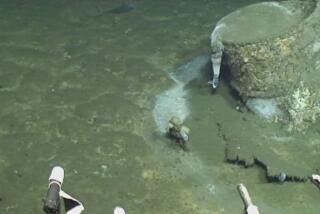U.S. Tells of ‘40s Radiation in Northwest
WASHINGTON — Residents of the Pacific Northwest were exposed to large doses of radioactive iodine released at the Hanford, Wash., nuclear weapons plant during the 1940s, the Department of Energy acknowledged Wednesday.
The radiation exposure, which will be detailed today in a report to be released in Richland, Wash., by an independent panel of scientists, was sufficient to cause illness among people living in parts of Washington, Oregon and Idaho, the department said.
While the government has previously confirmed the release of radioactive iodine from the plant, the statement Wednesday by Energy Secretary James D. Watkins is the first official acknowledgment that the radiation could have affected the health of people living in the region.
Watkins said he had conferred with John Till, a nuclear engineer leading the scientific study, and conceded that it will show “significantly high” doses of iodine were released from 1944 to 1947 at the site. “The implications of the report are serious,” Watkins said.
Watkins said the total radioactivity released during a single episode at Hanford in 1945 was between 350,000 and 400,000 curies. A curie is the amount of radiation emitted in one second by 1,400 pounds of enriched uranium.
Watkins said the scientific report would estimate that some residents had been exposed over this period to as much as 3,000 rads. A rad is a measure of radiation equal to what is absorbed in about a dozen chest X-rays. By comparison, nuclear plant workers are limited by the government to an annual radiation exposure of five rads.
Watkins said it was unclear what the exact health effects of the releases were. “We don’t know who was at the right spot at the wrong time,” he said. “We’re primarily interested, of course, in the infants,” who are substantially more vulnerable than adults to such radiation.
A separate study by the federal Centers for Disease Control is addressing the actual cases of illness that may have resulted.
Anticipating today’s new disclosures about nuclear waste problems at the Hanford weapons complex, the department Wednesday shook up management of the sprawling plutonium production facility. It also announced it will sign an agreement today giving the Army Corps of Engineers a major role in the cleanup.
Watkins said Hanford’s future will be devoted to waste management and environmental restoration rather than production of fuel for nuclear warheads. He added that its new director and three deputies will report directly to the chief of the multibillion-dollar cleanup of the department’s contaminated weapons facilities.
Hanford now has some 600,000 cubic yards of radioactive waste in storage, including 2,100 tons of spent fuel rods from plutonium production reactors and 149 contaminated underground tanks that once held liquid wastes. So far, some 1,100 sites on the 560-square-mile reservation have been identified as requiring remediation.
Investigators from Energy Department headquarters are now completing another seven-week assessment and will shortly be reporting details of the cleanup requirements, Watkins said.
In the management shake-up announced Wednesday, Watkins chose John Wagoner, a veteran of both civilian and military nuclear power programs, to replace Michael Lawrence, who will leave the department at the end of July.
While he praised Lawrence as a “wonderful person,” Watkins acknowledged that he wanted a more aggressive management organization to tackle the cleanup, whose cost is still a subject of widely varying estimates.
A former admiral in the nuclear Navy, Watkins said he was shocked when he took over the nation’s nuclear weapons complex to find that it lagged far behind the civilian nuclear industry in dealing with waste problems.
“When we start rattling the trees here, we get a lot more rotten apples down than we expected,” he said.
The memorandum of understanding to be signed with the Army Corps of Engineers will lay out national guidelines for the corps’ participation in the cleanup of weapons installations across the country.
More to Read
Sign up for Essential California
The most important California stories and recommendations in your inbox every morning.
You may occasionally receive promotional content from the Los Angeles Times.










